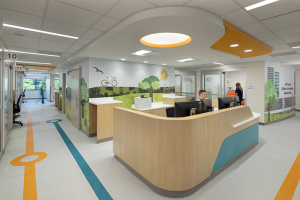Researching pediatric care environments

Children's hospital exterior playground.
Image courtesy of ASHE
The literature on evidence-based design, especially in health care, has exploded over the past two decades. We have an ever-expanding body of knowledge around environments for all types of adult patients and a growing number of studies on environments for aging populations.
There even are a good deal of studies on design for our smallest patients in birth environments and the neonatal intensive care unit. But what about pediatric patients? The Center for Health Design’s Knowledge Repository includes key studies on how the built environment can support pediatric care. Three recent articles are highlighted here.
One of the many challenges in researching pediatric environments is finding the best way to understand children’s perceptions. Creative research methodologies use play to elicit feedback from kids, and a study by Rubio and colleagues does this using Legos.
Children ages 6 to 11 years old were given Legos and asked to design and build their ideal hospital. The children designed facilities that included the things we all want, like gardens, good views, open spaces and opportunities for leisure such as TV and a swimming pool. They also included whimsical elements like “a flower that has a button to be able to play music.” The researchers found that children prioritized safety and comfort, suggesting things like a nightlight “that doesn’t bother you, so you don’t get scared.”
Efforts to reduce children’s fears and anxiety during the health care experience is a high priority for designers and providers, and it has become especially critical in the perioperative process. A study by Wingler and colleagues is centered on the experience of pediatric surgery and how the design of the induction room can play a role in reducing anxiety.
The research team compared anxiety for children and their parents during an outpatient tonsillectomy and/or adenoidectomy in either a surgery facility that uses induction rooms, or a surgery department in a hospital where induction occurs in the operating room. Anxiety was significantly lower for children who were induced in the induction room, but there were no differences between the parent groups.
Design for pediatric environments can support better outcomes not only for children and their parents, but for staff as well. A literature review from Sweden conducted by Bock and colleagues includes a study that found staff reported feeling less stress in single-patient rooms because they are quieter. But while the review was extensive, there was very little in the findings around how pediatric design actually impacts pediatric patients, and the authors describe the difficulty in finding quality studies on pediatric environments.
Research around design for these patients is sparse, and designers are often forced to finagle the findings from studies focused on adults into pediatric spaces. But this young population has different needs, and we need more research to better understand how to address those needs and to inform innovative design solutions.
To read more on what we do know about pediatric facility design, as well as several other topics related to health care design, visit The Center for Health Design’s Knowledge Repository.
Research used for this column
The following citations from The Center for Health Design’s Knowledge Repository of health care design resources were used by the author when writing this column:
- Navarro Rubio, “The Children’s Council as a Mean of Participation in a Hospital,” American Journal of Nursing Studies 2 (2021): 3.
- D. Wingler, et al., “Perioperative Anxiety in Pediatric Surgery: Induction Room vs. Operating Room,” Pediatric Anesthesia 31, no. 4 (2021): 465–73.
- E. Pauli Bock, et al., “Literature Review: Evidence-Based Health Outcomes and Perceptions of the Built Environment in Pediatric Hospital Facilities,” Journal of Pediatric Nursing, 2021, in press.




